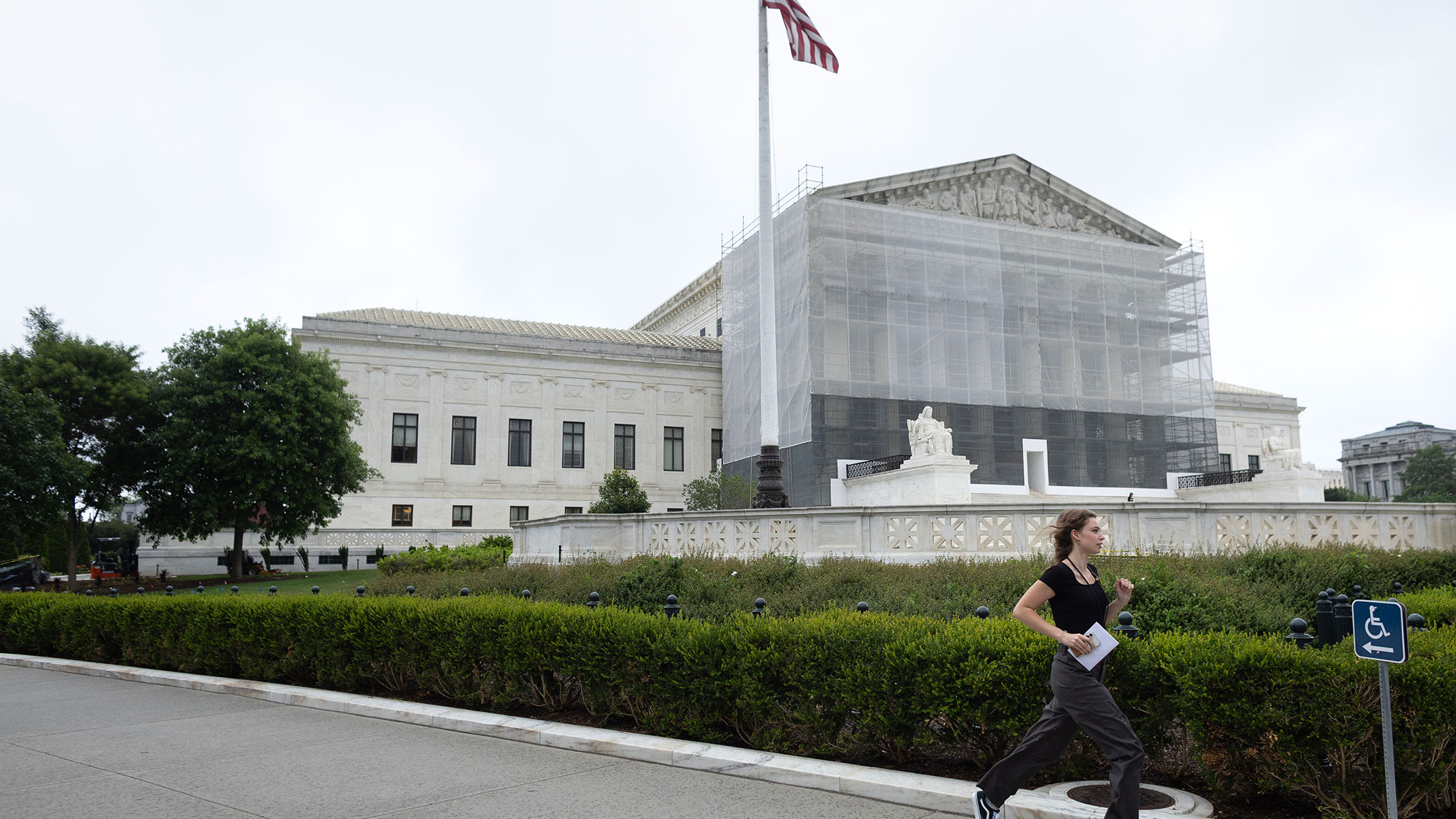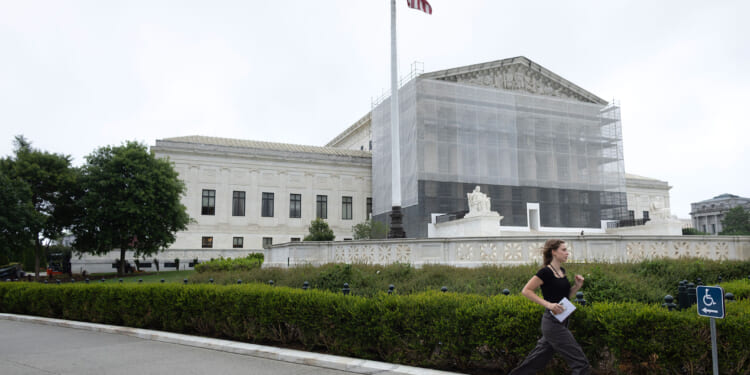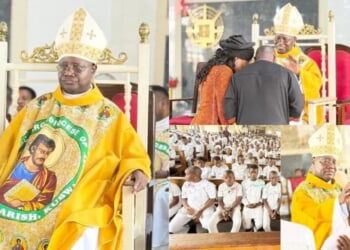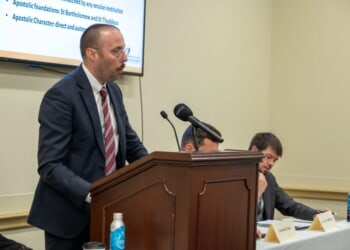
After an eventful summer of travel, teaching, and book tours, the Supreme Court justices are back—except it feels like they never left. Normally, we court-watchers and legal pundits digest the big cases that come down at the end of June, argue about what it all means, and then enjoy a few months to catch our breath and prepare for the next slew of briefs and arguments. But this year, the justices kept us all busy with a constant stream of rulings on the emergency docket.
Rested or not, the show must go on. Here’s a quick-and-dirty guide to cases to watch in the 2025–2026 Supreme Court term, grouped into three buckets: sex and gender identity, politics, and executive power.
Finally, a reason to check your email.
Sign up for our free newsletter today.
In Chiles v. Salazar, the Court will consider the constitutionality of a ban on certain forms of talk therapy for gender dysphoria. The case involves a licensed counselor, Kaley Chiles, who challenged a Colorado law that prohibits mental-health professionals from providing “conversion therapy,” which it defines as “any practice or treatment . . . that attempts or purports to change an individual’s sexual orientation or gender identity.” Chiles argues that the law censors conversations between counselors and their clients based on the viewpoints expressed; it effectively allows talk therapists only to “affirm” clients’ gender identity. The Tenth Circuit found that the law merely regulates professional conduct that “incidentally involves speech,” over a strong dissent by Judge Harris Hartz.
The facts here appear to be the inverse of those in last term’s United States v. Skrmetti case, which involved a state ban on certain medical procedures used to treat gender dysphoria. But unlike Skrmetti, the Court in Chiles will rule on First Amendment grounds and won’t examine whether the law discriminates based on sex or sexual orientation. (The Manhattan Institute filed a brief supporting Chiles that represents the interests of Jewish and Muslim therapists.)
In Little v. Hecox and West Virginia v. B.P.J., the Court will take up state laws restricting girls’ sports to biological females. Both cases involve the Fourteenth Amendment’s Equal Protection Clause and Title IX, the federal law ensuring equal educational opportunities for women and girls. In Hecox, the Ninth Circuit held that Idaho’s law, the first of its kind in the nation, is unconstitutional, while in B.P.J., the Fourth Circuit ruled that West Virginia’s law violates Title IX; in both cases, the courts ruled that the states had discriminated based on sex.
The Court’s rulings in these cases are likely to be an actual inverse of its holding in another controversial case, Bostock v. Clayton County (2020), where the justices read protections for sexual orientation and gender identity into Title VII, the federal employment-discrimination law. Justice Neil Gorsuch, the author of that opinion, has consistently limited its application to Title VII, and I can’t imagine that he—let alone a majority of his colleagues—would change course here. (Note that the plaintiff in Hecox is trying to moot that case by abandoning any intent to participate in women’s sports, but B.P.J. will remain on the docket, even if that tactic succeeds.)
Turning to political cases, Bost v. Illinois State Board of Elections asks whether federal candidates can challenge state time, place, and manner regulations of federal elections under Article I’s Elections Clause. Illinois state representative Mike Bost, joined by two Republican officials, sued their state’s election administrators over a state law allowing mailed ballots postmarked by Election Day to be counted if received within 14 days, or, if a ballot’s postmark is missing or illegible, to be counted if signed and dated before Election Day. A district court dismissed the suit for lack of standing, which the Seventh Circuit affirmed over a dissent by Judge Michael Scudder. Super-lawyer Paul Clement represents the challengers, arguing that Congress set uniform election standards that preclude the state regulations here. At the very least, however, the plaintiffs have plausibly alleged a substantial risk that counting mail-in ballots received after Election Day will harm their electoral prospects.
In National Republican Senatorial Committee v. Federal Election Commission, the Court will examine a challenge to campaign-finance restrictions on spending when coordinated between parties and candidates. The Court upheld such limits in a case known as Colorado II (2001), rejecting a First Amendment challenge by a 5–4 vote. But that ruling is an outlier, because the only government interests in restricting political speech that the Court recognizes are preventing quid-pro-quo corruption or its appearance, both absent here. Subsequent decisions, including Citizens United, have reinforced this understanding. Legislative amendments and the experience of states that don’t restrict party-candidate coordination further undermine the validity of Colorado II. (The Manhattan Institute filed an amicus brief, authored by former FEC chairman Brad Smith, which supports the challengers and argues that Congress lacks any authority to regulate political speech.)
Louisiana v. Callais presents the justices with the recurring goldilocks question in redistricting cases of how to get states to consider race enough to give racial minorities the opportunity to “elect a candidate of their choice,” as the Court’s own Voting Rights Act (VRA) jurisprudence requires, while not so much as to violate constitutional equal-rights protections. The dispute began when black voters sued over a congressional map that Louisiana’s legislature adopted after the last Census. While that map contained one majority-black district (out of six), nearly a third of the state’s population is black, so the voters claimed “dilution” under Section 2 of the VRA. After federal courts ordered the state to draw a new map, Louisiana did so, this time including a second majority-black district. That prompted a lawsuit from “non-African American” voters, who argued that the new map was an illegal racial gerrymander.
A federal court agreed with these challengers, and the Supreme Court took up the case. Louisiana argued that it was stuck navigating the VRA as interpreted by lower courts and the Constitution’s prohibition on governmental racial discrimination. The state admitted that once the legislature was ordered to draw a second majority-black district, it focused on protecting Republican incumbents, including House Speaker Mike Johnson. The challengers used that admission to argue that the state had considered race first, then politics. The Supreme Court was unable to resolve the issue and, at the end of last term, ordered further briefing on whether Louisiana’s creation of a second majority-minority district violates either the Fourteenth Amendment (which prohibits states from treating people differently without good reason) or the Fifteenth (which bars the federal and state governments from denying or abridging the right to vote based on race). The Court this term is likely to throw up its hands and get out of the business of policing “voter dilution” claims, as opposed to claims of actual racial discrimination in voting.
Finally, executive power. In First Choice Women’s Resource Center v. Platkin, the Court will determine whether nonprofit organizations can go to federal court to challenge state investigatory subpoenas by asserting associational and privacy rights. It’s a complicated case but raises a momentous issue at a time of politically polarized lawfare. New Jersey’s attorney general, acting for “consumer protection,” subpoenaed a faith-based pregnancy center, seeking information about its donors, advertisements, personnel, and allied relationships. First Choice immediately went to federal district court to seek a preliminary injunction and temporary restraining order. The court dismissed the case, holding that a challenge to a state subpoena isn’t ripe (ready to be considered by a court) until a state court enforces the demand. The Third Circuit denied an injunction pending appeal, but at the same time, New Jersey’s attorney general got favorable rulings in state court to enforce his subpoenas.
The case returned to the district court, which again denied an injunction based on ripeness. The Third Circuit affirmed over a dissent by Judge Stephanos Bibas, who found the case to be indistinguishable from the donor-disclosure demands that the Supreme Court quashed in Americans for Prosperity v. Bonta (2021). Now, the Court will decide if that’s true. (The Manhattan Institute filed what we hope will be our last of several briefs in this saga, arguing that First Choice’s claims are ripe because it faces compelled disclosure of its donors under threat of monetary sanctions.)
Then we have the tariffs cases, consolidated under the name Learning Resources, Inc. v. Trump. The legal issue boils down to whether the International Emergency Economics Powers Act (IEEPA), a 1977 law authorizing the president to “deal with any unusual and extraordinary threat, which has its source in whole or substantial part outside the United States, to the national security, foreign policy, or economy of the United States,” justifies President Trump’s executive orders that imposed “trafficking tariffs” on imports from Canada, China, and Mexico and “reciprocal tariffs” on imports from elsewhere.
IEEPA gives the president the power, in a national emergency, to “regulate . . . importation” of “property in which any foreign country or a national thereof has any interest.” Assorted small businesses and states filed lawsuits, with three trial courts ruling in their favor. The Federal Circuit, which hears appeals from the Court of International Trade, agreed with the challengers by a 7-4 vote. “The Executive’s use of tariffs qualifies as a decision of vast economic and political significance,” the majority explained with some understatement, so the government had to “point to clear congressional authorization” to justify its actions. That explicit authority was lacking, the majority concluded.
This case is a big deal, to say the least, and the Court could ultimately rule in ways that don’t give either side a conclusive win. For example, it could define “emergency,” “unusual and extraordinary threat,” or “property in which any foreign country . . . has any interest” and remand the cases back to the lower courts initially to apply those new standards. What it likely won’t do is invoke the “nondelegation doctrine” to say that Congress can’t delegate the tariff power to the president; if five justices wouldn’t find an impermissible delegation in last term’s Federal Communications Commission v. Consumers Research, which involved authority for the Universal Service Fund (see the fine print on your cellphone bill), five justices certainly won’t do so in a case involving Donald Trump’s signature policy initiative.
Finally, in Trump v. Slaughter, the Court will consider whether the president can remove members of the so-called “independent” agencies only “for cause” (malfeasance or incompetence), as held by its 1935 precedent Humphrey’s Executor v. United States. That 90-year-old decision, involving Franklin Roosevelt’s attempt to fire a member of the Federal Trade Commission, held that heads of agencies wielding “quasi-legislative or quasi-judicial” power are insulated from presidential removal over mere policy differences or a desire to install loyalists. Half a century later, Morrison v. Olson (1988) extended Humphrey’s Executor to nearly all high-ranking officials. Justice Antonin Scalia, then in just his second term on the Court, wrote a solo dissent demonstrating how clearly such cases infringe on the separation of powers.
Following Scalia’s logic, the Court over the past 15 years has invalidated certain restrictions on presidential removal in a series of cases: Free Enterprise Fund v. Public Company Accounting Oversight Board (2010), Seila Law LLC v. Consumer Financial Protection Bureau (2020), and Collins v. Yellen (2021). Now, it faces the very agency at the heart of Humphrey’s Executor. Earlier this year, the Court telegraphed its leanings when it stayed a district court’s injunction against Trump’s removal of members of the National Labor Relations Board. (But note that the issue in Slaughter is different than the attempted for-cause removal of a member of the Federal Reserve Board of Governors, the subject of another case the Court just set for argument, Trump v. Cook.)
There are two other cases worth mentioning that don’t fit into any of those buckets. In Case v. Montana, the Court will take up a bread-and-butter Fourth Amendment issue for the first time in many years, looking at whether police can enter a home without a search warrant under the “emergency aid” exception based on less-than-probable cause of an active emergency. Professors of constitutional criminal procedure are salivating. In Wolford v. Lopez, the Second Amendment returns to the Court after the Ninth Circuit split from the Second Circuit in allowing a state (here, Hawaii) to ban the carrying of handguns by licensed permit holders on private property that is open to the public unless the property owner gives express permission.
We’ll be talking about many of the above cases again next June, but also about others coming down the pipeline—such as the return of the executive order on birthright citizenship—and still others below the radar. All we know for sure is that it won’t be a boring year at the marble palace of the nation’s highest court.
Photo by Tom Brenner For The Washington Post via Getty Images
Source link


















